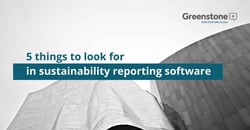5 things to look for in sustainability reporting software
 Sustainability reporting involves data, data and more data. The demand for greater transparency, accurate and reliable information and continuous monitoring against targets is growing. With reporting requirements constantly increasing, a huge volume of data needs to be collected, managed and reported across an organisation.
Sustainability reporting involves data, data and more data. The demand for greater transparency, accurate and reliable information and continuous monitoring against targets is growing. With reporting requirements constantly increasing, a huge volume of data needs to be collected, managed and reported across an organisation.
One way to improve sustainability and ESG data management is to implement sustainability and ESG reporting software to automate and streamline the process. However, finding the right software solution for your business isn’t always straightforward. With the ever-evolving sustainability and ESG reporting landscape, you need to be sure that the software you choose is going to fulfil your non-financial, sustainability, supply chain and ESG reporting requirements both today and in the future.
Whether you are moving beyond spreadsheets for the first time or looking to replace an existing system that isn’t working for your business, knowing where to start your search and what to look for can be a bit overwhelming.
Below are 5 things to look for in sustainability and ESG reporting software.
-
Usability – is it intuitive and easy to use?
Having a sustainability and ESG reporting software solution that is intuitive and easy to use, particularly for first-time users, is very important. If a system is intuitive and easy to navigate, you’ll get people using it quickly and ultimately engaging with your sustainability initiatives. Unlimited restrictions on user profiles will ensure each person’s access gives them exactly what they need.
Another thing to consider is whether the sustainability reporting software solution integrates with other systems. If the data managed in your ESG software can automatically feed into other systems or vice versa, this not only increases ease of use but also streamlines data management across your organisation.
-
Analytics and reporting – does the range of analytics and reporting meet your stakeholder requirements?
Sustainability reporting isn’t just the responsibility of the sustainability department anymore; it’s on the agenda and requires the collaboration of many different stakeholders. In particular, investors are starting to demand information on sustainability, ESG and exposure to climate risk.
When selecting sustainability reporting software, you’ll need to consider whether the analytic tools and reporting available will fit the reporting requirements of all of your stakeholders. It’s also important to consider whether it will give you the results from your data that will help you engage with different audiences and help you make better-informed business decisions.
-
Implementation - what is the implementation process?
Understanding the implementation process, and the timelines involved, in your selected sustainability and ESG reporting software is important. Not only so you know what to expect and what you need to prepare, but to ensure your selected software provider has the appropriate training and roll-out plans in place. For example, the number of upfront training days to get your team up to speed on the software is something to consider. And, if you think the number of days is unreasonably high, maybe you should question the usability of the solution.
If you are transitioning from another system, it’s also useful to find out how the transition is managed and how continuity risk is minimised. For example, will both systems run alongside each other to avoid any downtime?
-
Future-proofing – will the sustainability reporting software be fit for purpose in 5 years’ time?
As ESG reporting requirements increase, so does the volume and scope of data that you need to manage. When selecting software, think about whether the solution will evolve with your reporting requirements and adapt to your changing organisational structure in years to come.
Sustainability reporting software takes investment in time and resources to implement so you need to be sure that the solution has the capability and innovation to grow with you. The software should be robust and flexible enough for your reporting both now, and in 5 years’ time, to enable you to achieve your long-term goals.
-
Ongoing support - what kind of support do you get?
Once you have selected and implemented your ESG reporting software solution, it’s important that you have access to the ongoing support to help you get the most from it. All too often organisations implement software and then find they don’t get the customer support they need.
And it shouldn’t be just about the software either. You should think about whether you are confident that you’ll get subject matter support and best practice advice to support your broader sustainability reporting strategy.
"Greenstone’s software and supporting services have been instrumental in supporting our sustainability journey to ensure we have access to accurate and meaningful data that can help us set and achieve our long-term goals.“
Robin Tindall, Environmental Stewardship Team Leader, Hypertherm
Greenstone worked with Hypertherm to migrate all of its historical environmental data into Greenstone’s Enterprise and fully implement the software across the organisation. Learn more about the challenges and discover the results - Download the full project case study.
Greenstone, through its award-winning sustainability reporting software solutions, enables its clients to move away from time-consuming data collection; to in-depth reporting and analysis and real decision-making. Talk to us to find out more.
Continue reading: Key aspects to consider in sustainability reporting
Learn more about our sustainability and ESG software solutions:
How Greenstone's Environment module is enabling responsible business (greenstoneplus.com)
How Greenstone’s ESG software can enable Scope 3 reporting (greenstoneplus.com)









